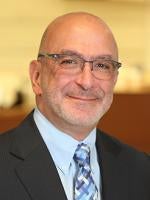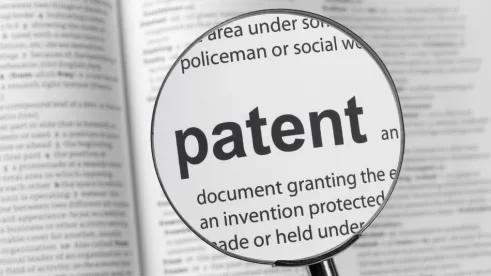In Myco Industries, Inc. v. BlephEx, LLC,[1] decided April 3, 2020, the Federal Circuit reversed a district court’s preliminary injunction which forbade a patent owner from accusing others of patent infringement. The Federal Circuit found a lack of a finding of bad faith in the patent owner’s accusations of infringement. The Federal Circuit also found errors in the district court’s claim construction and infringement analysis, and remanded the case for further analysis of the merits.
The Technology and Accusations at Issue
The technology at issue relates to a method of using an electromechanical device with a swab to remove debris from a portion of the eyelid known as the eyelid margin area. Buildup of such debris can cause a disorder known as blepharitis. An eyelid margin has two regions: the posterior eyelid margin (where posterior blepharitis can arise) and the anterior eyelid margin (where anterior blepharitis can arise).
The dispute between the accused infringer (Myco) and the patent owner (BlephEx) focused, among other things, on whether the patent claims covered a method of treating only posterior blepharitis, or posterior and anterior blepharitis as well.
In 2019, the inventor, Mr. Rynerson of BlephEx, and a competitor, Mr. Choate of Myco, hosted booths at a trade show. Mr. Rynerson noticed that Myco was offering a product to treat blepharitis. Stories from Mr. Rynerson and Mr. Choate conflicted substantially over whether and how any accusations of patent infringement may have arisen, but both stories had the inventor raising some kind of issue of patent infringement upon visiting the competitor’s booth. Mr. Rynerson claimed that he only asked about whether Myco’s product might infringe. Mr. Choate claimed that Mr. Rynerson was hostile, and that Mr. Rynerson made loud accusations of infringement that Myco’s potential customers could hear.
The District Court’s Grant of Preliminary Injunction
Myco filed a declaratory judgment action against BlephEx, the patentee, claiming non-infringement because Myco’s device is only for treating anterior blepharitis, while the patent only claims a method of treating posterior blepharitis. Myco also sought a preliminary injunction against Myco’s making false allegations of infringement, and against making baseless threats against Myco’s potential customers.
The district court found that Myco was likely to prevail on its claim of non-infringement, finding that the patent claims were limited to treating posterior blepharitis based on the patent’s description, and on the patent applicant’s amendments to the patent claims before the patent issued. The district court also held that, to the extent that Myco’s potential customers were doctors, those customers were immune from infringement liability under 35 U.S.C. § 287(c)(1). The court also held that it could not establish that BlephEx made any false or misleading statements about Myco’s product, but nonetheless enjoined BlephEx from making allegations of patent infringement and from threatening litigation against Myco’s potential customers.
BlephEx appealed.
The Federal Circuit’s Reversal and Remand
Failure to Establish Required Bad Faith
There were two primary aspects on which the Federal Circuit focused. First, the Federal Circuit found that “’federal law requires a showing of bad faith’ before a patentee can be enjoined from communicating his patent rights”.[2] The Federal Circuit also noted that, in order to show bad faith, the claims asserted must be objectively baseless, meaning that “no reasonable litigant could realistically expect success on the merits”.[3]
The Court noted that patentees are entitled to notify potential infringers of the existence of patent rights, so that a potential infringer can decide whether to stop its activities, negotiate a possible license, or risk liability and the imposition of an injunction.[4]
The Federal Circuit noted further that, to the extent that the district court made any factual findings relevant to bad faith, the district court expressly declined to find that any of the patent owner’s statements was false or misleading. The Federal Circuit held that this fact alone warranted reversal, finding that the district court abused its discretion by using an erroneous legal standard by failing to rely on a finding of bad faith as a predicate for the award of preliminary injunctive relief.[5] Myco argued that, procedurally, BlephEx had waived this argument, but the Federal Circuit held that a party cannot waive the proper standard of review by failing to argue it.[6]
One interesting aspect of the court’s discussion focused on a distinction between immunity from infringement versus lack of remedy for infringement. This issue derived from Myco’s potential customers being medical practitioners. Ordinarily, if a medical practitioner is found to infringe by performing a medical activity, the patentee cannot seek a remedy for infringement against the practitioner or related health care entity. 35 U.S.C. § 287(c)(1). The lack of a remedy against a practitioner does not, however, make an infringement allegation a bad faith allegation. Practitioners’ activities could serve as required underlying direct infringement for any accusation of indirect infringement that BlephEx might have made against Myco.[7]
Faulty Claim Construction Does Not Necessarily Preclude Infringement
Second, the Federal Circuit determined that the patent’s prosecution history did not justify limiting all of the claims to treatment of a particular type of blepharitis. The court noted that claim 1 of the patent recited the capability of treating anterior blepharitis, whereas other claims were more specific to treating anterior blepharitis. Consequently, the doctrine of claim differentiation presumptively would prevent limiting claim 1 in such a fashion.[8]
In addition, the Federal Circuit noted the applicant did not accept the Examiner’s proposed claim 1 amendment which would have imposed that kind of limitation. The resulting agreement with the Examiner resulted in claim 1 reciting a method of using a device with the capability of accessing the inner edge, but not requiring such contact during use. Consequently, it did not necessarily follow that Myco’s product, treating posterior blepharitis, avoided infringement of claim 1.
The Federal Circuit acknowledged the relevance of the prosecution history in informing claim scope where claim language is ambiguous. But the court contrasted this prosecution history role from the doctrine of prosecution disclaimer, which requires “clear and unmistakable” disavowal of claim scope.[9] The Federal Circuit found no such disavowal here. The court also faulted the district court’s claim construction as focused on the patent specification’s description of the patent owner’s own product, rather than on the recited claim limitations.[10]
Takeaways
When a party feels falsely accused of patent infringement, it is natural to believe that the patent owner’s allegations are in bad faith. However, in order to prove bad faith, it is necessary to establish two things: i) non-infringement; and ii) objectively baseless accusations of infringement. The Myco decision serves as a reminder that, absent bad faith, a patent owner is entitled to say what it thinks its patent covers. An appropriately notified potential infringer can decide how to proceed—e.g. leave the business, redesign the product, negotiate a license, or perhaps take a chance on litigation, liability and possible injunction.
The decision also serves as a reminder that it is not possible to seek a remedy for patent infringement from medical practitioners engaged in medical activities, while at the same time those practitioners’ actions can serve as predicate acts of direct infringement in order to establish indirect infringement, for example, by medical device manufacturers.
[1] 2020 U.S. App. LEXIS 10510 (Fed. Cir., April 3, 2020).
[2] 2020 U.S. App. LEXIS 10510, *17 (citing GP Indus., Inc. v. Eran Indus., Inc., 500 F.3d 1369, 1373 (Fed. Cir. 2007)).
[3] Id. at *17-18 (citing Prof’l Real Estate Investors, Inc. v. Columbia Pictures Indus., Inc., 508 U.S. 49, 60 (1993)).
[4] Id. at *18 (citing Va. Panel Corp. v. MAC Panel Co., 133 F.3d 860, 869 (Fed. Cir. 1997), Mikohn Gaming Corp. v. Acres Gaming, Inc., 165 F.3d 891, 897 (Fed. Cir. 1998)).
[5] Id. at *18-19 (citing Coursey v. Comm’r of Soc. Sec., 843 F.3d 1095, 1097 (6th Cir. 2016)).
[6] Id. at *19 (citing United States v. Ali, 508 F.3d 136, 144 n.9 (3d Cir. 2007); Brown v. Smith, 551 F.3d 424, 428 n.2 (6th Cir. 2008)).
[7] Id. at *21-22 (citing Barry v. Medtronic, Inc., 914 F.3d 1310, 1334 (Fed. Cir. 2019)).
[8] Id. at *26-27 (citing Aspex Eyewear, Inc. v. Marchon Eyewear, Inc., 672 F.3d 1335, 1348 (Fed. Cir. 2012).
[9] Id. at *27-28 (citing Sorensen v. Int’l Trade Comm’n, 427 F.3d 1375, 1378-79 (Fed. Cir. 2005), Personalized Media Comm’cns, LLC v. Apple, Inc., 952 F.3d 1336 (Fed. Cir. 2020), and Tech. Props. Ltd. LLC v. Huawei Techs. Co., 849 F.3d 1349, 1357-58 (Fed. Cir. 2017)).
[10] Id. at *28 (citing Int’l Visual Corp. v. Crown Metal Mfg. Co., 991 F.2d 768, 772 (quoting ACS Hosp. Sys., Inc. v. Montefiore Hosp., 732 F.2d 1572, 1578 (Fed. Cir. 1984))).




 />i
/>i

